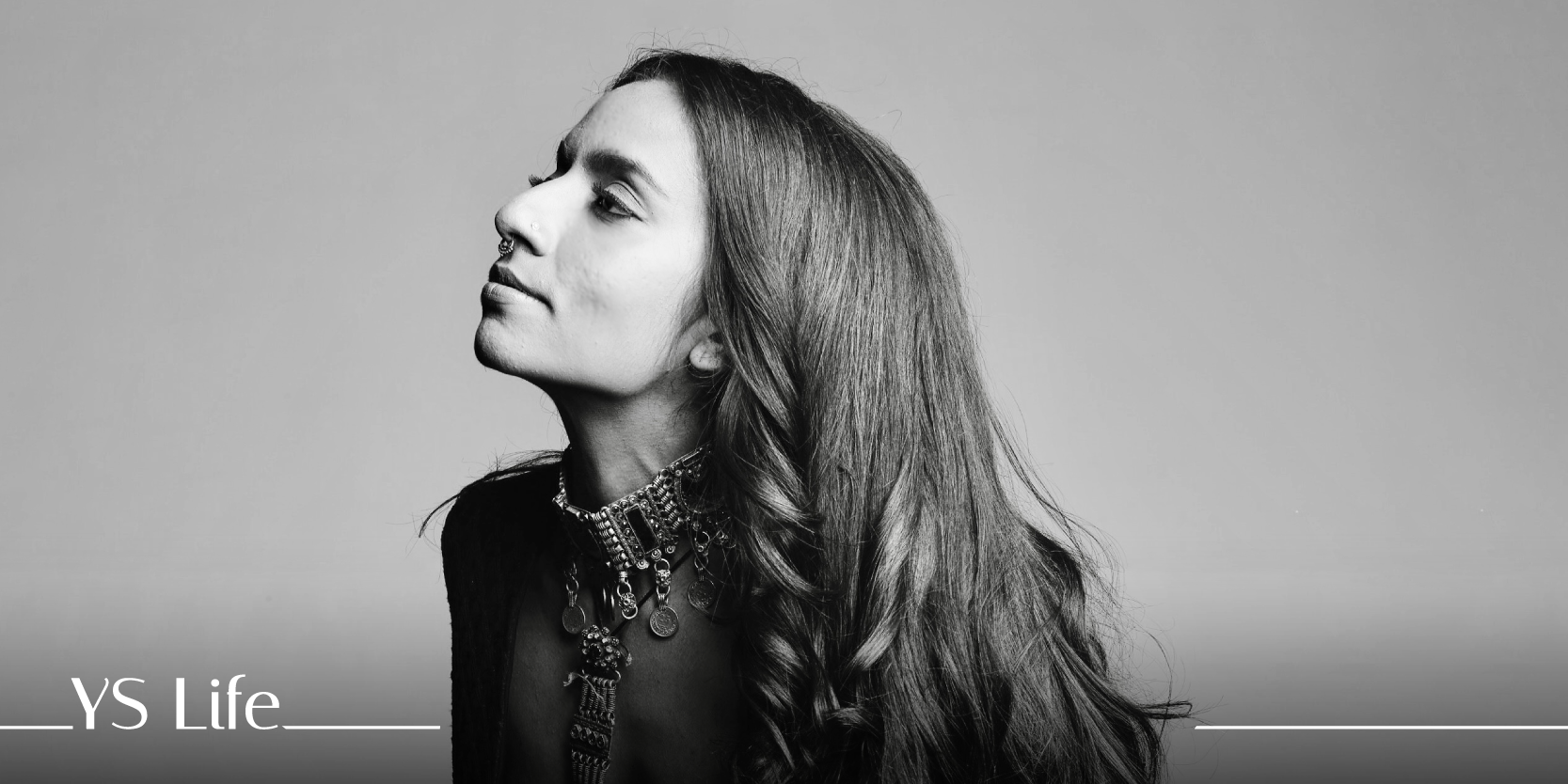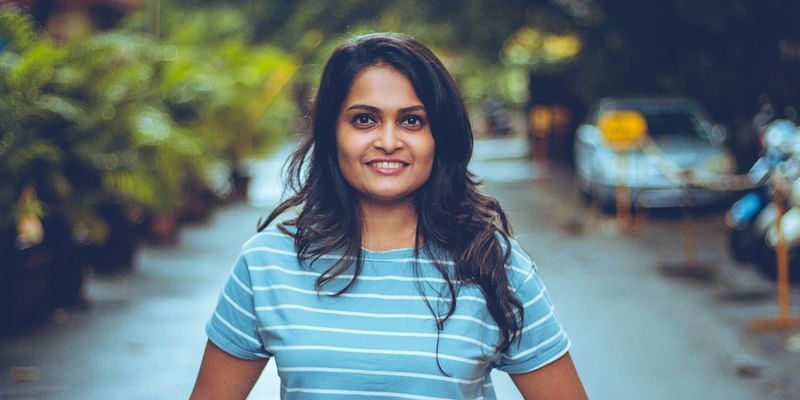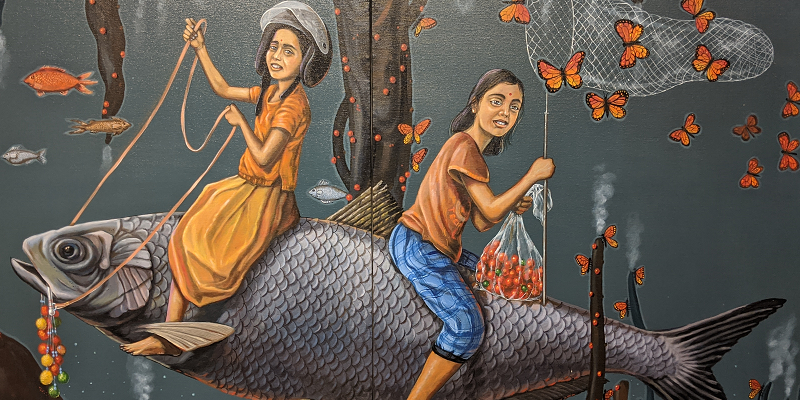Being an artist is the most natural thing to do: contemporary artist Shilo Shiv Suleman
Indian artist Shilo Shiv Suleman gets candid about being rebellious, her inspiration, and what it means to be a celebrated artist’s daughter.
It is not uncommon for daughters to seek inspiration from their talented mothers and also follow in their footsteps. But for contemporary Indian artist Shilo Shiv Suleman, it was important to create an individual identity while looking up to her mother and renowned artist Nilofer Suleman.
Shilo started painting when she was only 13 years old, at a time when her mother had shifted her focus from cartography to creating art in the intricate miniature style and documenting and archiving the history of Indian culture.
She describes her relationship with her artist mother as “spectacular”.
“Niloufer and I actually have the best sort of friendship. Some of our biggest fights have been about art and colours, and some of our shared and greatest ecstasies have been making exhibitions together. It has always been such a special thing to have someone in the family who speaks exactly the same language as you and understands it. We painted a world and stepped into it,” says Shilo, in a candid conversation with YS Life.

Shilo Shiv Suleman
While the mother-daughter duo grew together with art around them, none of them really followed each other’s path, creatively.
“I am too rebellious to be mentored by anyone. Despite us both being artists, I found my own way to be able to be completely individual,” says Shilo.
Growing up listening to the stories of people like Frieda Kahlo, Matisse, and Raja Ravi Varma, painting came naturally to Shilo.
“When I was growing up, I was very dreamy, imaginative and creative. I continuously had my head in the clouds, and that sense of magical realism, seeing the magic in even the most ordinary, mundane circumstances is something that still carries forth with my work quite a lot,” she tells us.
Shilo’s art focuses on social change and technology. In recent years, she has been engaging with biofeedback technology and the interaction between body and art. She has created large-scale installations that beat with one’s heart, applications that react to one’s brainwaves, and sculptures that glow with one’s breath.
More recently, Shilo collaborated with Scotch whisky brand Johnnie Walker Black Label for a series of limited-edition bottles illustrating a vision of Delhi, using the Air-Ink technology that converts pollution into ink.
In a conversation with YS Life, Shilo discusses her inspiration, her art form, and her recent collaboration with Johnnie Walker Black Label.
Edited excerpts from the conversation:
YS Life (YSL): Do you look up to any artist when it comes to seeking inspiration?
Shilo Shiv Suleman (SS): Despite my rebellion (nature), I will still name Niloufer first!
Aside from that, I draw inspiration from a lineage of women–Amrita Sher-Gill and Frieda Kahlo. A lot of the sensuality in my work is definitely inspired by artists like Gustav Klimt, the mythological themes are inspired by Raja Ravi Varma. So I definitely kind of stand on the shoulders of my art ancestors.
In terms of contemporary artists, Sir Raghava K K is both my friend and mentor. He tends to be very experimental–working with AI to jumping into NFT universes.

Shilo Shiv Suleman
YSL:How would you describe your art?
SS: I would say my work is feminine, utopic, magical realist, full of wonder, and also is kind of at the intersection of art and technology. So a lot of the work that I do in my own private or personal practice really looks at how we can use technology to be able to create experiences of wonder. And so that’s how I would describe myself.
YSL: Please share some details of the illustrations for the limited edition of Johnnie Walker Black Label.
SS: When they approached me, they wanted me to do an ode to my city. And the first city that came to my mind was Delhi.
Delhi really represents the diversity of Indian culture and romance in a sense that perhaps other cities like Mumbai or Bengaluru do not embody. When I think about Delhi, I imagine the foggy days in the old city, waking up early in the morning and going to Chandni Chowk, and seeing the beautiful tombs and parts of history that kind of emerge out of the fog and the winding gullies in the old parts of the city.
While there is magic and romance on one hand, as a woman I feel unsafe navigating public spaces in Delhi. So when I was creating the design for the bottle, I started to think if I could imagine absolute sovereignty and freedom in that city–walk freely and meander my way across the gullies without feeling the sense of fear, and just really holding the magic of the city close to my heart and what that would feel like.
The illustration that I have made has women wearing all kinds of clothes–some wearing more traditional clothes, some of them are clocked in shawls as we often are during winters, walking quite freely across the streets. That was one part of the inspiration.

Shilo Shiv Suleman has collaborated with Johnnie Walker Black Label for a series of limited-edition bottles illustrating a vision of Delhi, using the Air-Ink technology
The magic of the architecture in Delhi was another part of the inspiration. I really tried bringing back poetry to the city since Delhi inspired so many poets, who in turn have inspired so many generations of artists.
I have brought the past and the future together in the illustration–the past civilisations that have existed in the soil for centuries and the projection of a future where, as a woman, I can walk freely through the streets.
YSL: Why did you use Air-Ink for this particular illustration?
SS: I think it relates to a lot of my work. A lot of my work is about looking at the innocence of the blackness of the world, the hopelessness of the world, and alkalising it into something beautiful, hopeful and creative.
And sometimes the medium is the message. In this particular case, being able to use pollution that has been turned into a medium to create beauty is so symbolic. It is almost like an act of alchemy. And I think it is the role and responsibility of the artists on almost an archetypical level to remind people that everything can turn into something–all of our pain, pollution and dirt has the ability to transform and transmute into light and beauty.
YSL: What are some of the challenges that you had to overcome to be where you are today? Did being a woman affect your journey as an artist?
SS: I wouldn’t really say that it has affected my journey, but it has definitely informed my journey in the sense that, regardless of the field, we are still perhaps the second or third generation of women who have careers, are vocal, and occupying spaces that were never really their own. My grandmother got married at the age of 14 years in rural Rajasthan; to think about the changes that we have gone through in just two generations is quite incredible.
My art is absolutely feminine, even with the bottle that I have created for Johnnie Walker. My identity as a woman is very central to all of the work that I do. For me, being a woman is less of a distraction or a hindrance, it is more of a responsibility to be able to articulate the feminine in all the work that I do.
YSL: Did you face any challenges for pursuing art as a career?
SS: Even before the fear of wondering if it is viable to be an artist came, I had married my life to art.
Having said that, I do think that we need a kind of patronage in the art world and that needs to come from large brands and institutions. I am quite careful when I look at brand associations. I think it is a kind of patronage to the art world when a brand like Johnie Walker decides to collaborate with a bunch of artists from across the world.
Back in the day, artists like Ravi Varma would have patrons. Maharajas would commission beautiful pieces of work to them, and I think it is very important for institutions to be able to continue that patronage.
YSL: What inspires you to wake up every morning and choose art?
SS: For me, being an artist is the most natural thing to do.
Growing up in a space like India, beauty is something that we are all familiar with. Be it the gajra in our hair, the kajal that lines our eyes, or the way we draw patterns outside our houses–we need to decolonise some of our ideas of what we consider art, because for me, all of that is art as well.
A lot of young artists that I mentor, I often remind them that our art-making practice is not something that is separate from us. In fact, it is actually something that is completely natural to us.
YSL: What is your big dream?
SS: I think I am actually living my dream in a sense!
I have a studio space, called Banana, inside the Hawa Mahal in Jaipur, and it is the most glorious space. I wake up and walk into a Krishna temple courtyard every morning. I also have an imaginarium of sorts where I have an embroidery machine, where anything I can imagine can be made inside the studio, and it is inside a palace! So I am living the greatest fantasy that I can imagine.
I feel fear leads to the misuse of imaginatiaon. Love is the most active use of imagination, and magic is when your imagination starts to speak back to you. So I could have never imagined that I would find myself in this beautiful palace courtyard, creating this imaginarium!
I also have a piece of land in Bali inside a 1,000-year old water temple. I hope that it will become an art studio where anything can be created. So I definitely feel that I am living my greatest dream or fantasy.
Edited by Swetha Kannan











